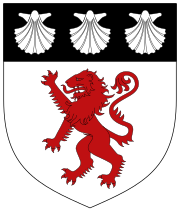The Cliffords
| Barony de Clifford | |
|---|---|
 
Arms of Russell, Barons de Clifford: Argent, a lion rampant gules on a chief sable three escallops of the first
|
|
| Creation date | 1299 (disputed 1605-1678, abeyant 1721-34, 1775-76, 1832-33) |
| Monarch |
Edward I Charles II (terminated abeyance) George II (terminated abeyance) George III (terminated abeyance) William IV (terminated abeyance) |
| Peerage | Peerage of England |
| First holder | Robert de Clifford, 1st Baron de Clifford |
| Present holder | John Russell, 27th Baron de Clifford |
| Heir presumptive | Miles Russell |
| Remainder to | Heirs of the body, lawfully begotten |
| Former seat(s) |
Appleby Castle Skipton Castle Brougham Castle |
Baron de Clifford is a title in the Peerage of England. It was created in 1299 for Robert de Clifford (c.1274–1314),feudal baron of Clifford in Herefordshire, feudal baron of Skipton in Yorkshire and feudal baron of Appleby in Westmoreland. The title was created by writ, which means that it can descend through both male and female lines. The Norman family which later took the name de Clifford settled in England after the Norman Conquest of 1066 and was first seated in England at Clifford Castle in Herefordshire. The first Baron served as Earl Marshal of England but was killed at the Battle of Bannockburn in 1314. His 8th generation descendant the 11th Baron, was created Earl of Cumberland in 1525, whose grandson the 3rd Earl was a noted naval commander. On the latter's death in 1605 the earldom passed to his younger brother, the 4th Earl (see the Earl of Cumberland for later history of this title).
The barony of de Clifford was claimed in 1628 by his daughter and only child, Anne Clifford, but the House of Lords postponed the hearing. The barony remained dormant until 1678, when Nicholas Tufton, 3rd Earl of Thanet, was allowed to claim the peerage and became the fifteenth Baron de Clifford. He was the son of Lady Margaret Sackville, daughter of the aforementioned Anne Clifford. On the death in 1721 of the Earl's younger brother, the sixth Earl, the earldom and barony separated. The earldom was inherited by the late Earl's nephew, the seventh Earl (see the Earl of Thanet for further information on this title).
The barony fell into abeyance between the Earl's five daughters, Lady Katherine, Lady Anne, Lady Isabel, Lady Margaret and Lady Mary. It remained in abeyance until 1734 when the abeyance was terminated in favour of the third daughter, Margaret, who became the nineteenth Baroness. She was the wife of Thomas Coke, 1st Earl of Leicester. On her death in 1775 the title again fell into abeyance, this time between her sisters and their heirs. The abeyance was terminated only a year later in favour of Edward Southwell, the 20th Baron. He was the grandson of Lady Catherine Tufton, eldest daughter of the sixth Earl of Thanet. He was succeeded by his son, the 21st Baron. He was childless and on his death in 1832 the barony fell into abeyance between his sisters Hon. Sophia Southwell and Hon. Elizabeth Southwell and the heirs of his deceased sister Hon. Catherine Southwell.
...
Wikipedia
